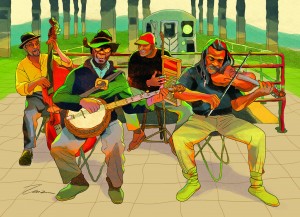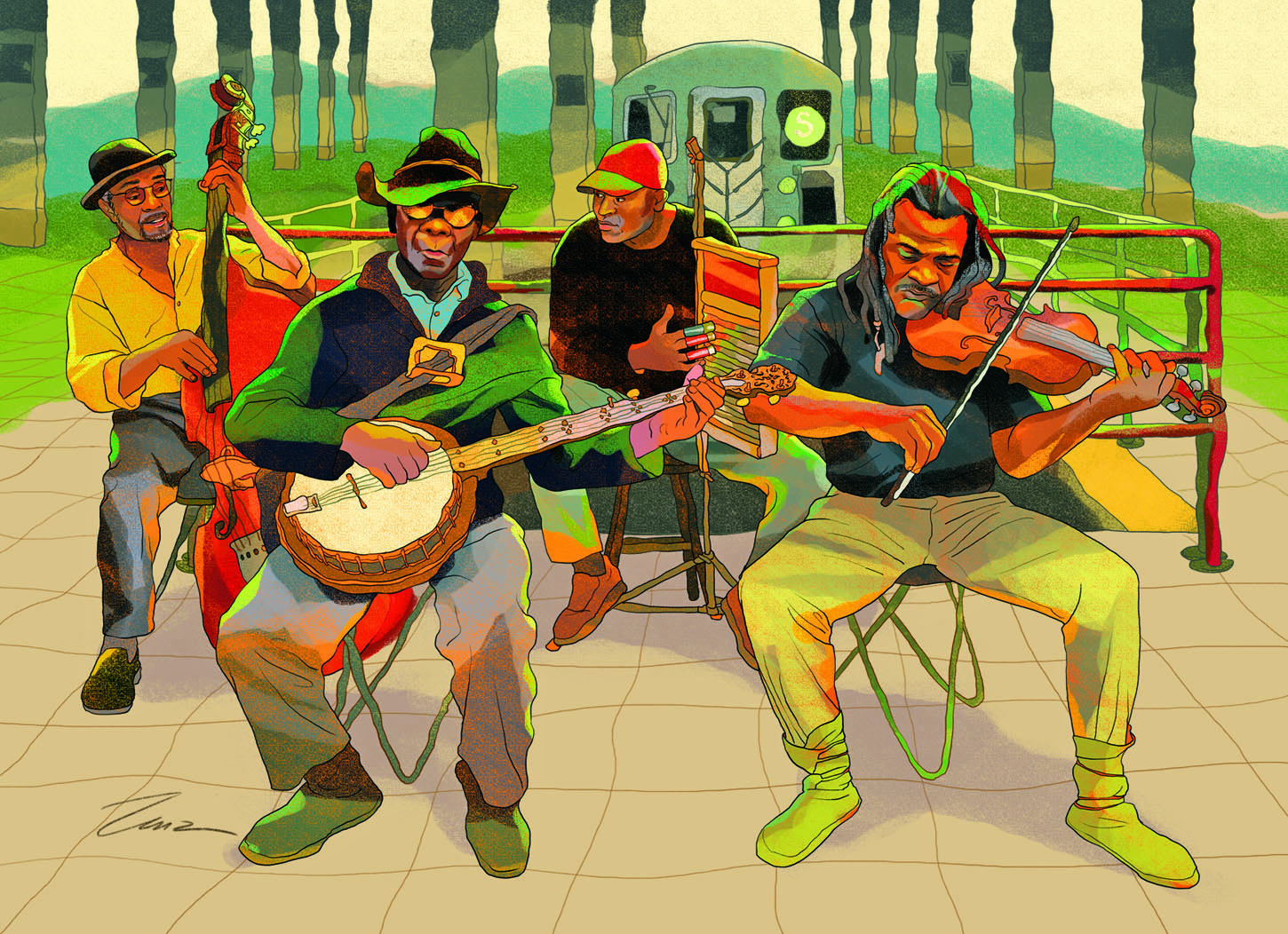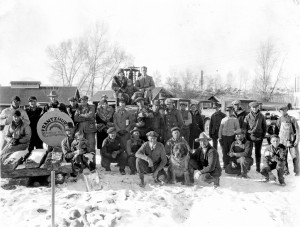by Mike Rosso and Elliot Jackson
Many Americans might be tempted to conjure up pictures of barefoot, dentally-challenged Appalachians when they hear the words “string-band” or “old-timey music.” Almost needless to say, they will think of it as “white music.” In fact, this music does has deep roots in the experience of white immigrants from the British Isles and Ireland. The early settlers of Appalachia played their own versions of ancient tunes brought over from their homelands. Blues, jazz, country music, even rock and roll has its origins in these tunes found throughout the Eastern mountains and the deep South of the United States.

One thing these folks might not necessarily reflect on when they think of old-time music is its equally deep roots in the music and instrumentation brought over from Africa. The banjo originated in Africa as a fretless instrument made from a gourd. Enslaved Africans in colonial America adapted their own version using animal skins. Even the fiddle has a one-string traditional African cousin, the iriti. But perhaps because of its connection to the experience of slavery and such outmoded forms of entertainment as the black-face minstrel shows, the African-American connection to string band music fell out of the public eye and ear in the wake of the urbanization of the blues into R & B, soul, rock and roll and hip-hop.
Which is what makes the Ebony Hillbillies that much more intriguing. A group of black musicians from New York City doesn’t exactly fit the stereotype of old time fiddle and string bands. This unlikely-sounding group does indeed exist, however, and is bringing its talents to Colorado for the first time this summer when they appear at the High Mountain Hay Fever Festival in Westcliffe and at the Salida SteamPlant this July.
The band was originally formed back in the 1980s by fiddler Henrique (Rique) Prince, a Harlem native who now lives in Queens. Other famous musical residents of Queens were Louis Armstrong, Ella Fitzgerald, Count Basie, Billie Holiday, Fats Waller, Dizzie Gillespie and James Brown.
He just “picked up” old time fiddle when he used to live in Manhattan and would hike to the top of a hill on the east side of Central Park early in the morning to practice. He went on to play square dances in the 1980s.
The Ebony Hillbillies became known for their spontaneous performances at a New York subway platform and have gone on to perform at such venues as Carnegie Hall and Lincoln Center as well as for the International Bluegrass Music Association in Nashville. This past June they sold out the 1,700 seat venue at the Spoleto Festival in Charleston, South Carolina, and performed in February at the Mark Twain Center in Hartford, Connecticut, accompanying readings from “Adventures of Huckleberry Finn.”
The current lineup is Rique on fiddle and vocals, Norris Bennett from Buffalo, NY on banjo, mountain dulcimer, guitar and vocals, Virginian Newman Baker on lap washboard and William “Salty Bill” Salter on acoustic upright bass. To give you some idea of the unusual range of this group of musicians, Salter has two Grammy awards under his belt for two hit songs he has written: “Where is the Love,” recorded by Roberta Flack and Donny Hathaway, and “Just the Two of Us,” recorded by both Grover Washington Jr. and Bill Withers.
The Hillbillies’ upcoming new release, “Barefoot and Flying,” is being produced by Richard Alderson at Mounsey Music Studios. Alderson has produced a variety of musicians from The Fugs, Spanky and Our Gang, Sun Ra, Aaron Neville, Nina Simone, Grover Washington Jr. and Muddy Waters. He was also Bob Dylan’s sound man at one time.
The Hillbillies’ general philosophy guiding the choice of the tunes they play, many of which originated in the Southeast, Texas and New Orleans, is “danceability.” They record mostly traditional tunes and songs, but Rique has written some originals including the title track of their first record, “Sabrina’s Holiday.”
The Ebony Hillbillies consider themselves part of a new movement of black string music and have influenced other bands including current darlings of the old-time scene, the Carolina Chocolate Drops. They are beginning to see more black audience members as their music catches on, and they believe all people find a connection to their roots in it. “It’s the engine that works for us” says Rique. “The old-time music is very danceable and brings you back to another time … it’s an antidote to modern music … people like organic music – no filler, no electronics.”
The Ebony Hillbillies find inspiration in old string bands and musicians such as fiddlers Cuje Bertram and Frank Patterson, banjoist Nathan Frazier and three-finger-banjoist Murph Gribble from Appalachia.
“The Gribble band played a free and easy improvisational style of string music, while Nathan Frazier and Frank Patterson played a surprisingly sophisticated style that is a window into a time of very high end playing in Eastern Tennessee,” said Rique.
A recommended collection of black string-band music from the Library of Congress is called Altamont. You can find out more about the band and their influences by visiting their website: www.ebonyhillbillies.com.
They will be performing in Salida on July 8 at the SteamPlant: www.salidasteamplant.com and in Westcliffe, July 9-11 at the High Mountain Hay Fever Festival: www.highmountainhayfever.com
Illustrator Zina Saunders has been featured in publications from the Wall Street Journal to The Nation Magazine. Her artwork is featured on the cover of the July 2010 issue of The Utne Reader. www.zinasaunders.com

